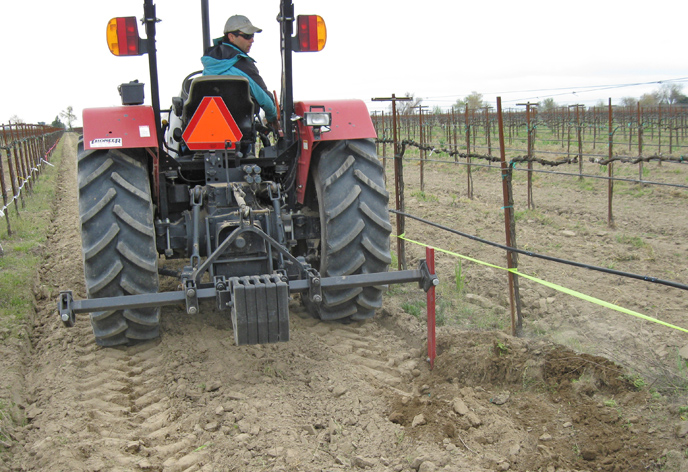California Agricultural Technology Institute

Treating berms with a Bezzerides cultivator in winegrape vineyard (driving tractor
is Geoff Dervishian, research scientist for Fresno State's Viticulture and Enology
Research Center).
Weed Control Trials
Research team tests organic management strategies
A series of vineyard weed control experiments designed to meet organic production standards have shown mechanical methods to be superior to steam or organically-accepted herbicides.
Leading the work was Fresno State Plant Science Professor Anil Shrestha, who designed the experiments with support from segments of the grape and wine industry.
“Weed management is an important problem faced by organic grape growers as there are few effective and economic options for weed control available,” the researcher said in outlining the study. “Because new organically acceptable weed control products have become available in recent years, we saw the need to analyze them and compare their efficacy.”
To help grape growers obtain comparative data on some of the newer methods, Shrestha examined three organic methods of weed control: thermal, mechanical, and organic herbicide application – to determine their effectiveness and cost.
Thermal involved the use of a device called a Stinger, which generates steam by heating water with a propane burner. The device is hitched on to a tractor. The mechanical method featured a French plow as well as a Bezzerides cultivator, specially designed for use in vineyards. The herbicide was an organically certified commercial product.
The experimental treatments were conducted in raisin and wine grape vineyards of two industry cooperators – Sun-maid in Kingsburg and West Coast Grape Farming in Madera.
According to Shrestha, the mechanical treatments were not only more effective in controlling weeds, they were also more cost effective. The plow provided the best control, eliminating 89 and 94 percent of weeds for four weeks after treatment in the raisin vineyard over the two seasons of the study.
The cultivator was second most effective, providing 70 and 79 percent control in two seasons of treatments.
In both years of the study the herbicide provided less than 70 percent control of the weeds, and most of the weeds had regrown within four weeks of treatment.
The steam treatment was likewise not as effective as the mechanical methods. Like the herbicide, up to 70 percent control of the weeds was obtained in the initial weeks, but the weeds regrew within three to four weeks.

Treating the berm with a French plow in the raisin grape vineyard.
Other aspects of each weed control method also must be considered by growers in deciding which to use, Shrestha stated. The plow, for example has its drawbacks: Although data were not recorded, the plow caused extensive soil disturbance and was often observed to injure grapevine roots. While the cultivator was not as effective as the plow, it was less disruptive to the soil and the vine roots.
In addition, mechanical cultivation can generate dust, which becomes a regulatory issue in California’s San Joaquin Valley, Shrestha said. And depending on the terrain, wind, and rainfall pattern, it may also accelerate soil erosion.
“So, each of these tools has certain advantages but also specific limitations for use in vineyards and in other cropping systems,” he said.
Another phase of the study included analysis of weed control treatment effects on vine growth, canopy characteristics, yield, and fruit composition. In these areas, no significant differences were recorded from the different treatments.
A key part of the project yet to be completed involves determining the overall energy use of each weed control method, Shrestha said.
“In recent years, assessment of ‘carbon footprint’ or greenhouse gas emissions from farm operations is considered an important component in determining the sustainability of agricultural cropping systems,” he said. “Grape growers in California are increasingly interested in better understanding its footprint.”
To obtain this information, research team members are examining the energy requirements of the different methods, from manufacturing and shipping pesticides to the amount of fuel used.
Assisting Shrestha in the work were viticulture research scientist Kaan Kurtural from Fresno State’s Department of Viticulture and Enology; economist Srinvasa Konduru from the Department of Agricultural Economics; viticulture specialist Matthew Fidelibus from the University of California, Davis; and a team of Fresno State graduate and undergraduate students.
Complete details of the experiment, including tables and charts, are contained in an article in the February issue of HortTechnology. Shrestha is also disseminating information through other media. For more information, he may be contacted ashrestha@csufresno.edu.
Partial funding for this project was from the California State University Agricultural Research Institute (ARI). Matching funds were provided by the Propane Education and Research Council, the California Raisin Marketing Board, and the USDA Viticulture Consortium West.